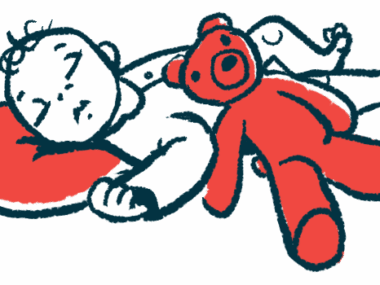Risdiplam Defies SMA ‘Natural History’ in Type 1 Infants, FIREFISH Data Show
Written by |

Roche’s experimental oral treatment risdiplam can safely and effectively halt disease progression in infants with type 1 spinal muscular atrophy (SMA) under 7 months of age, according to top-line data from Part 2 of the FIREFISH trial.
After one year of treatment, most of these 41 babies were alive, able to breathe and swallow, and showed clinically meaningful motor function improvements — “things that don’t happen in the natural history” of the disease, Paulo Fontoura, MD, PhD, said in an interview with SMA News Today. Fontoura is global head of neuroscience and rare disease clinical development for Roche.
“These results confirm the clinically meaningful efficacy of risdiplam in infants with an advanced and difficult-to-treat disease,” Levi Garraway, MD, PhD, Roche’s chief medical officer and head of Global Product Development, said in a press release.
Risdiplam — developed by Roche and Genentech in collaboration with PTC Therapeutics and the SMA Foundation — is a daily liquid treatment that works by increasing the levels of the SMN protein, essential for muscle health and lacking in people with SMA.
As a flavored liquid, risdiplam can be easily administered orally or given through a feeding tube to a broad range of SMA patients in terms of age and disease severity.
According to Fontoura, ease of use is one of risdiplam’s strengths, as the therapy can be started the day after a diagnosis and that “will be a key point for patients or physicians making a choice.”
FIREFISH’s ‘pretty remarkable’ results
The global, two-part, Phase 2/3 FIREFISH study (NCT02913482) is evaluating risdiplam in infants with type 1 SMA, a severe form, enrolled at ages 1 to 7 months.
Part 1 assessed the safety of two different doses of risdiplam in 21 babies (median age about 7 months) and determined that the higher dose was the optimal dose for the trial’s second part.
Part 2 is currently evaluating this dose’s safety and effectiveness in another 41 type 1 infants, who began treatment at median age of 5.3 months, for two years.
Its primary goal is the percentage of these babies, now toddlers, able to sit without support for at least five seconds after one year of treatment, as determined by the Gross Motor Scale of the Bayley Scales of Infant and Toddler Development Third Edition (BSID-III). This part of the scale measures both large and fine motor abilities and control.
Secondary goals include measures of SMN blood levels and changes in motor function and milestones using the BSID-III, the Hammersmith Infant Neurological Examination 2 (HINE-2), and the Children’s Hospital of Philadelphia Infant Test of Neuromuscular Disorders (CHOP-INTEND).
CHOP-INTEND, which also assesses motor skills in infants, uses a 0–64-point scale, with higher scores indicating better motor function. Without treatment, CHOP-INTEND scores for SMA type 1 babies drop over time. Increases of at least four points are considered clinically meaningful.
Average baseline (starting) scores of untreated SMA type 1 infants age 6 months or younger range from 20 to 22, as opposed to an average score of 50.1 in age-matched healthy babies, the NEURONext natural history study of SMA reported. A score of 40 or greater for type 1 infants is rarely observed.
Results from FIREFISH’s first part showed that 88% of those babies given risdiplam at the higher dose — selected as Part 2’s optimal dose — achieved at least a four-point increase in CHOP-INTEND scores, while 56% of them achieved a score of more than 40 points.
No FIREFISH patient is now being treated at a lower risdiplam dose. “All babies in Part 1 have been moved up to the therapeutic dose, and we’re collecting clinical data on them,” Fontoura said.
Newly released Part 2 data show that the trial met its primary goal and several of its secondary goals. At the time of the analysis, patients’ median age was 20.7 months, and they had been treated for a median of 15.2 months.
After one year of treatment, 12 (29%) infants were able to sit without support for five seconds — meeting the trial’s primary goal — 18 (43.9%) achieved upright head control, 13 (31.7%) were able to roll to the side, and two (4.9%) were able to stand with support.
“These babies never sit up. The fact that you’re having almost 30% of them sitting for five seconds unassisted after 12 months of treatment, I think that’s pretty remarkable,” Fontoura said.
As was seen in Part 1 at the optimal dose, babies in Part 2 (all given this dose) had a median increase of 20 points in CHOP-INTEND scores, with 90% showing at least a four-point increase and 56% achieving a score above 40 — which is “kind of close to normality — what a normal baby would look like,” Fontoura said.
Notably, 93% of them were alive and 85.4% did not require ventilation or any other type of intensive support. Of the 38 babies alive at 12 months, 36 (95%) maintained an ability to swallow and 34 (89%) were able to be fed orally.
In the natural history of type 1 SMA, untreated babies require feeding support by 12 months old, and need to be placed on permanent ventilation, or die, at a median age of 13.5 months.
Three enrolled babies died of their disease, all within the first three months of treatment. Their deaths were not considered by researchers to be related to risdiplam’s use.
Fontoura emphasized there are no signs that any of these toddlers are reaching a plateau, or leveling, in terms of motor improvements and milestones.
“Some of them faster, some of them slower, but they’re all essentially gaining in motor milestones,” he said.
Risdiplam, importantly, is also continuing to show a “fantastic” safety profile, consistent with that previously reported and with no new safety concerns or risdiplam-related unwanted events.
“These are very sick children, so you have a lot of adverse events, problems like upper respiratory tract infections [46.3%], pneumonias [39%], diarrhea [9.8%] … at essentially very comparable rates as natural history,” Fontoura said.
But “there was really no detection of any drug-related adverse events … and that’s also true over longer duration, which with safety is what you worry about,” he said.
“These results are particularly encouraging given the median age at enrolment was 5.3 months, so these infants already had progressed disease,” Laurent Servais, a FIREFISH investigator and professor of pediatric neuromuscular diseases at the MDUK Oxford Neuromuscular Centre, said in the release.
Looking ahead
Detailed FIREFISH Part 2 data were meant to be presented at the 2020 American Academy of Neurology (AAN) annual meeting, set to open April 25 in Toronto, but canceled due to the COVID-19 pandemic. Roche plans to share the results through a virtual presentation in the coming weeks.
According to Fontoura, China is now the eighth country where risdiplam is under regulatory review, with others being the U.S., Brazil, Chile, Indonesia, Russia, South Korea, and Taiwan. Filing of a marketing application to the European Medicines Agency is expected around mid-year.
Due to a recent extension of risdiplam’s review by the U.S. Food and Drug Administration (FDA), a decision in the U.S. is now expected on or before Aug. 24.
A separate study of risdiplam is still enrolling eligible patients at a dozen sites in nine countries, including the U.S. Called RAINBOWFISH (NCT03779334), this trial is treating newborns up to 6 weeks old with a genetic diagnosis of SMA but no evidence of symptoms (presymptomatic).






